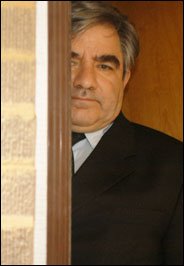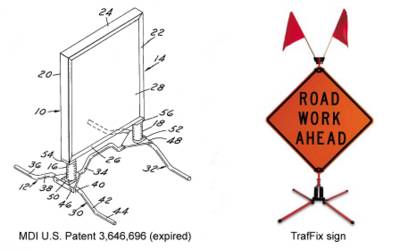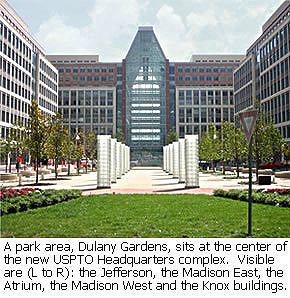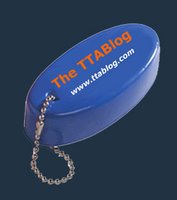TTABlog Quarterly Index: April - June 2007
Tip from the TTABlogger: never move. After a week of packing and (partial) unpacking, finding my lost keyboard, and fiddling unsuccessfully with my wireless network, I'm glad to see this quarter draw to a close. [Meanwhile, please note that e-mail subscriptions to the TTABlog are available. Just enter your e-mail address in the box on the right to receive a daily update.]

Section 2(d) - Likelihood of Confusion:
- TTAB Finds Water and Soy Shake Mix Related, Sustains 2(d) Opposition to "REVIVAL WATER"
- TTAB Decides "FIRST NIAGARA" Oppositions After CAFC Reversal on Issue of Use
- Finding Wine-Imbibing Consumers More Susceptible to Confusion, TTAB Deems "SAURUS" and "LAURUS" Confusingly Similar
- Precedential No. 36: TTAB Finds Paper Towel Designs Confusingly Similar, Sustains 2(d) Opposition
- Attempt to Limit Goods in Cited Registration Goes Nowhere; "GO-FOR" Applicant Loses TTAB 2(d) Appeal
- "YSL" and "SL" Logos for Jewelry Confusingly Similar, TTAB Rules
- "H2OPTIX" and "H2OVERX" Confusingly Similar for Sunglasses, Says TTAB
- Finding "KEWPIE" a Strong Mark for Dolls, TTAB Sustains 2(d) Opposition to "ROSE O'NEILL KEWPIE" for Kitchenware
- Precedential No. 34: Section 2(d) Opposer Fails to Prove Priority as TTAB Rejects Analogous Use Argument
- Divided TTAB Panel Finds "EZ BED" for Air Beds Confusingly Similar to "EASYBED" for Retail Services
- Finding Family of "SEXY" Marks, TTAB Sustains 2(d) Opposition to "SO SEXY" for Hair Care Products
- TTAB Turns Deaf Ear to Bose Corp.'s Petition for Cancellation of "ELECTRONIC LIFESTYLES" Registrations
- Fame of "GOOGLE" Blows Away "BLOGLE" in TTAB 2(d) Summary Judgment
- TTAB Finds "KING RANCH" and "RANCH KING" Confusingly Similar for Hats
- TTAB Sustains 2(d) Opposition, Deems "VOLKSWAGEN" and "Volks-bagen" for Luggage Confusingly Similar
- Precedential No. 31: TTAB Finds "RATED R SPORTSWEAR" Confusingly Similar to the Famous "RATED R" Movie Certification Mark
- TTAB Affirms 2(d) Refusal, Dubiously Discards "PARTYPAL" for Disposable Plate with Beverage Holder
- Precedential No. 29: TTAB Finds "ASSOCIATION OF THE UNITED STATES ARMY" Logo Confusingly Similar to "U.S. ARMY" Logo, Sustains 2(d) Refusal
- Precedential No. 28: "CLUB PALMS MVP" Confusingly Similar to "MVP" for Casino Services, TTAB Rules
- Precedential No. 27: Board Finds Family of "HOG" Marks, Sustains 2(d) Opposition to "DIRT HAWG" and "WATER HAWG" for Wet and Dry Vacuums
Section 2(e)(1) - Mere Descriptiveness:
- "EQUITY RESIDENCE CLUB" Merely Descriptive of Real Estate Development Services, Says TTAB
- Addition of "THE" to "LID" Does Not Avoid Mere Descriptiveness for Cargo Trailer Covers, Says TTAB
- TTAB Panel Majority Reverses Mere Descriptiveness Refusal of "WELDKIT" for Auto Suspension Systems
- TTAB Finds "ALL-AMERICAN" Not Merely Descriptive of Cookies and Crackers, Dismisses Oppositions
Section 2(e)(4) - Primarily Merely a Surname:
Section 2(f) - Acquired Distinctiveness:
- Precedential No. 39: Proof of Acquired Distinctiveness Falls Short for "ALPINE SPRING WATER"
- TTAB Denies Fraud Claim but Sustains Opposer's Attack on Acquired Distinctiveness of "ALGAE WAFERS" for Fish Food
- Precedential No. 26: TTAB Finds Certification Mark Specimens Adequate, but "CRNA" Lacking in Acquired Distinctiveness
Bona fide Intent:
Dilution:
Fraud/Nonuse:
- Precedential No. 41: Service Mark Application with False Use Claim is Void ab initio
- TTAB Cancels "PERFECT VODKA" Registration: Sale of a Single Bottle Was Not Sufficient Technical Trademark Use to Support Registration
- TTAB Again Says Correction of False Statement Before Publication Avoids Fraud
- Precedential No. 30: Registrant's Misunderstanding No Excuse, TTAB Finds Fraud and Cancels "ELLE BELLE" Registration for Clothing
- TTAB Denies Fraud Claim but Sustains Opposer's Attack on Acquired Distinctiveness of "ALGAE WAFERS" for Fish Food
Genericness:
- TTAB Finds "THE MADELEINE COOKIE COMPANY" Generic, Ineligible for Supplemental Register
- Finding "KEWPIE" a Strong Mark for Dolls, TTAB Sustains 2(d) Opposition to "ROSE O'NEILL KEWPIE" for Kitchenware
- TTAB Finds "NAIL CARE" Generic for Nutritional Supplements
- Precedential No. 33: "DORSAL NIGHT SPLINT" Generic For Orthopedic Splints Worn at Night, Says TTAB
- Precedential No. 32: "LENS" Generic for Internet Sale of Contact Lenses, Says TTAB
- CAFC Affirms TTAB Decision: "LAWYERS.COM" Refused as Generic
Mere Ornamentation/Not a Trademark
Ownership:
Specimen of Use/Mutilation:

Procedural Matters:
- Precedential No. 42: TTAB Lets Respondent off the Hook, Accepts Late-Served Admission Responses
- Precedential No. 40: Petition to Cancel Registration on Ground that Portion of Mark is Generic is Time-Barred by Section 14(3)
- Precedential No. 38: TTAB Dismisses Cancellation Petitioner's Inadequately Pleaded Section 14(3) "Misrepresentation of Source" Claim
- Precedential No. 37: Cancellation Respondent's Laches Claim Survives Section 8 Cancellation of its Registration
- TTAB Turns Deaf Ear to Bose Corp.'s Petition for Cancellation of "ELECTRONIC LIFESTYLES" Registrations
- TTAB Applies Res Judicata, Sustains Opposition to Re-filed "CALVO" Application
- Precedential No. 25: Is IZZY'S Cancellation Petition Barred By Laches? It Isn't, Says TTAB
- TTAB Dismisses "I ♥ NY" Opposition to "I ♥ NC" Due to New York's Failure to Prove Priority
CAFC Decisions:
- CAFC Finds "CHI" Marks Confusingly Similar for Electric Massagers, Reverses TTAB
- Divided CAFC Panel Affirms TTAB: "ASPIRINA" Merely Descriptive of Analgesics
- CAFC Affirms TTAB Decision: "LAWYERS.COM" Refused as Generic
Recommended Reading:
- Recommended Reading: Horlander, "The U.S. Constitutional Limits of Product Configuration Trade Dress Rights"
- "Foreign Equivalents" Article from The Trademark Reporter
Leo Stoller:
- No Joy in Leoville: PTO Cancels 34 "STEALTH" Registrations
- Chicago Federal Court Issues Order Restraining Leo Stoller's Filing of New Lawsuits
Meet The Bloggers III:
- Four More Bloggers at "MEET THE BLOGGERS III"
- The TTABlogger Meets Sammy Davis, Jr.
- Two Views of INTA Chicago 2007
- "MEET THE BLOGGERS III" Highlights INTA Monday TTABlog Special Report: How to Find the Billy Goat Tavern
- Mark Your Calendar: "MEET THE BLOGGER III"
- "MEET THE BLOGGERS III" Set For Monday Evening, April 30
Other:
- TTAB Posts June 2007 Hearing Schedule
- Shootout at the CA1 Corral: "M4" Found Generic for a Certain Carbine Rifle
- TTAB Posts May 2007 Hearing Schedule
- Likelihood of Confusion Blog Reports on Hasidic Trademark Dispute
- "Famous Marks" Doctrine Not Found in Federal Law, Says 2nd Circuit
- USPTO Five-Year Strategic Plan Calls for Improvement in TTAB Case Processing
Text and photographs Copyright John L. Welch 2007.


































